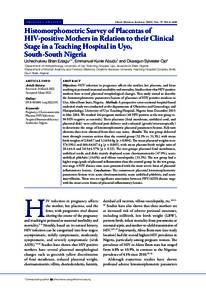Document
Histomorphometric survey of placentas of HIV-positive mothers in relation to their clinical stage in a teaching Hospital in Uyo, South-South Nigeria.
Identifier
DOI 10.5001/omj.2022.103
Contributors
Abudu, Emmanuel Kunle., Author
Ojo, Olusegun Sylvester., Author
Publisher
Oman Medical Specialty Board.
Gregorian
2022-11
Language
English
Subject
English abstract
Objectives: HIV infection in pregnancy affects the mother, her placenta, and fetus
resulting in perinatal/maternal morbidity and mortality. Studies show that HIV-positive
mothers have several placental morphological changes. This study aimed to describe
the histomorphometric parameters/lesions of placentas of HIV-positive mothers in
Uyo, Akwa Ibom State, Nigeria. Methods: A prospective cross-sectional hospital-based
analytical study was conducted at the departments of Obstetrics and Gynecology, and
Histopathology, University of Uyo Teaching Hospital, Nigeria from December 2015
to May 2016. We studied 144 pregnant mothers (48 HIV-positive as the test group vs.
96 HIV-negative as controls). Their placentas (fetal membrane, umbilical cord, and
placental disk) were collected post-delivery and evaluated (grossly/microscopically)
to determine the range of histomorphometric placental parameters/lesions. Relevant
obstetric data were obtained from their case notes. Results: The test group delivered
more through cesarean section than the control group (52.1% vs. 31.3%), with mean
birth weights of 2.8±0.7 and 3.1±0.6 kg (p = 0.004). The mean placental weights were
57±190.1 and 664.6±167.4 g (p = 0.003), with mean placenta-birth weight ratio of
20.1±4.8 and 20.5±4.57% (p = 0.33). The test groups placental fetal membranes,
umbilical cords, and disks mainly displayed acute chorioamnionitis (47.9%), acute
umbilical phlebitis (14.6%), and villous vasculopathy (33.3%). The test group had a
higher stage/grade of placental inflammation than the control group. In the test group,
two stage 4 HIV disease state cases presented with the most severe form of placental
inflammatory lesions. Conclusions: The commonest placental histomorphometric
parameters/lesions were acute chorioamnionitis, acute umbilical phlebitis, and acute
intervillositis. There was no significant association between HIV/AIDS disease stage
with the most severe forms of placental inflammatory lesions.
Member of
Resource URL
Citation
Eziagu, Uchechukwu Brian, Abudu, Emmanuel Kunle, & Ojo, Olusegun Sylvester (2022). Histomorphometric survey of placentas of HIV-positive mothers in relation to their clinical stage in a teaching Hospital in Uyo, South-South Nigeria. Oman Medical Journal,
Category
Journal articles

